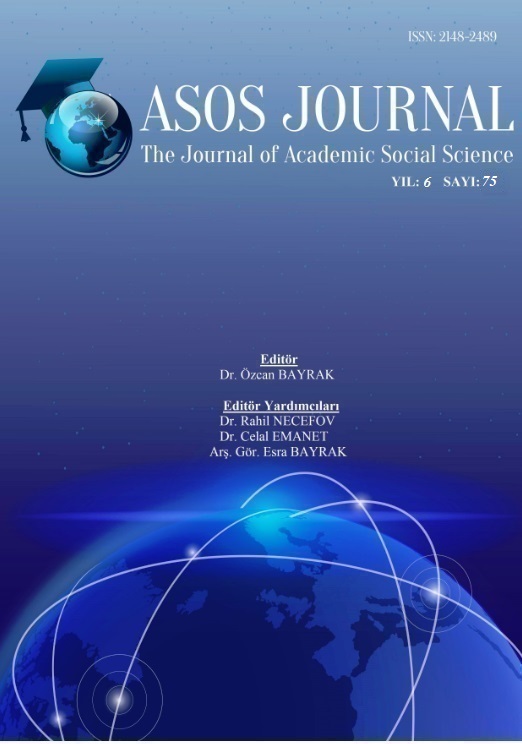Author :
Abstract
Çağdaş Türk Resim Sanatında kendine özgü plastiği ve resim dili, tek bir üsluba indirgenemeyecek kadar değişken ve zengin bir kadın sanatçı olan ; Fahrelnissa Zeid’in (d.1903,İstanbul-ö.1991,Amman/Ürdün )sanat anlayışının ele alındığı bu çalışma ;literatür tarama modelinde gerçekleştirilmiştir. Türk kadın sanatçılar arasında özgün bir kimlik olarak hem dünya hem de çağdaş Türk resim sanatında yerini alan Fahrelnissa Zeid’in sanat anlayışı ve eserleri ile sınırlandırılmıştır. Araştırmada aynı zamanda; Fahrelnissa Zeid’in Çağdaş Türk Resim Sanatının oluşum süreci içerisindeki yeri ve önemini vurgulamak amaçlanmıştır. Fahrelnissa Zeid’ i ve sanat hayatı içerisinde bulunduğu dönemi de ele alan bu araştırmada ayrıca; Orta Doğu’nun mistik dünyasının içinden bir kadın ressamın, soyut resimler yapması, sanat eleştirmenleri ve tarihçileri açısından, sanatçının özgünlüğünü oluşturacak özel kaynakları saptamaktadır.Zeid’in, bir batılı için gizemli ve Osmanlı İmparatorluğu’nun seçkin bir aile ortamında Zeid ‘in resminde İslami hat ve minyatür sanatlarının estetiği ile tasavvufun mistik karakterlerini görmek mümkündür. Eserlerini bir dönem, Paris’te bulunduğu yıllarda etkilendiği Bizans ve Batı sanatının estetiği ile harmanlamıştır. Resimlerinde kaligrafik, ritmik ,ahenkli geometrik çizgileri ve güçlü renkleri onun baskın karakterini ortaya koymaktadır. Hem Paris hem de İstanbul'da eğitim gören Fahrelnissa Zeid, 1940’ların başında Türk avangart gruplarının, 1950'lerde ise École de Paris’in önemli sanatçısıdır. Dev boyutlu soyut kompozisyonları ve cesaretli dinamik tasarımlarıyla, doğunun mistik kültürel dokusunun renklerini ve biçimini izlerini batı sanatının evrensel kaideleriyle birleştirerek özgün sanat eserlerine dönüştürür. Yakaladığı evrensel dil onu dünya sanatı tarihinde 1950’lerin École de Paris’in içinde önemli bir konum da yer almasını sağlar.
Keywords
Abstract
This study of Fahrelnissa Zeid’s understanding of art (Birth 1903, Istanbul -Death.1991, Amman / Jordan) was carried out in a literature review model. In Contemporary Turkish Painting Art, with her unique plastic and painting language, she is a variable and versatile female artist who cannot be reduced to a single style. The study is limited to Fahrelnissa Zeid's understanding of art and works of art, which have taken place both in the world and in contemporary Turkish painting art as a unique identity among Turkish women artists. At the same time, it is also aimed in the research to emphasize the place and importance of Fahrelnissa Zeid in the formation process of Contemporary Turkish Painting. Also dealing with Fahrelnissa Zeid and the period of her art life, this research determines special resources to create the artist's authenticity in terms of art critics and historians upon the fact that a woman from the mystical world of the Middle East could come up with abstract paintings. It is possible to see the aesthetics of Islamic calligraphy and miniature arts and the mystical characters of mysticism in Zeid’s works, a mystery for a westerner and in the exclusive family atmosphere of the Ottoman Empire. She blended her works with the aesthetics of Byzantine and Western art, by which she had been influenced during her stay in Paris. Calligraphic, rhythmic, harmonious geometric lines and strong colours in her works reveal her dominant character. Having studied both in Paris and in Istanbul, Fahrelnissa Zeid was an important artist of Turkish avant-garde groups in the early 1940s and of École de Paris in the 1950s. With giant-dimensional abstract compositions and courageous dynamic designs, she transforms the traces of the colours and shapes of the mystical cultural texture of the east into the works of original art by combining them with the universal bases of western art. The universal language she captured gives her a place in the 1950's École de Paris in the history of world art.





